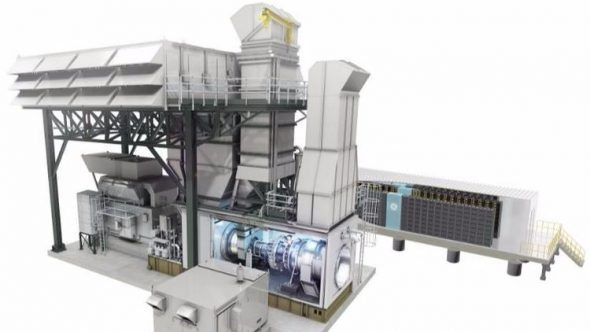South Australia’s plans to install a 250MW gas peaking plant is not what it seems: it now appears the government is looking to install world- first technology that combines gas-fired power with battery storage, a move that could help reshape the state’s energy market.
Energy minister Tom Koutsantonis dropped some hints of what he was looking at in Tuesday’s press conference. (RenewEconomy didn’t pick it up at the time because we had ducked out to talk to ABC Radio on the breaking news of the South Australia energy plan).
Koutsantonis had talked of a gas generator and battery storage, and it was assumed he was talking about the seperate tenders – the peaking gas plant and the 100MW battery storage.
But it turns out Koutsantonis was talking about a gas turbine that has a battery storage unit attached, which means that the turbine can spin without burning fuel – rather like a jet engine on the runway – and can provide instantaneous response to grid faults.
Who has such technology? As far as we can tell, only GE, which announced the “world’s first battery storage & gas turbine hybrid” with Los Angeles-based utility Southern California Edison last October.
GE has developed a product it calls the LM6000 Hybrid EGT (an artist rendition above). It includes a 10MW battery energy storage system, made by GE’s own battery storage offshoot Current, paired with an existing 50MW gas turbine, also made by GE, and known as an LM6000.
Such a system would allow South Australia to install up to 5 such units to meet its targeted 250MW, resulting in an extra 50MW of instant response battery storage spread across the grid, ensuring grid stability, and with 250MW of emergency capacity in case of a shortfall, or more baseload generators tripping.
This, along with the separate 100MW battery storage tender, is something of a game-changer for the energy market and marks a new way of thinking.
The idea of a peaking gas plant was criticised – we questioned why in this story: SA Power: Why so much gas when storage is so cheap – because it was seen as expensive and emissions intensive.
This technology will add instant response and smarts, and means that the state will not be held to ransom by existing players who have charged a fortune for grid stability because they control the market.
The addition of battery storage allow the turbine to operate in standby mode without using fuel and enables immediate response to changing energy dispatch needs.
GE, in its brochures, says that by eliminating the need to constantly run the turbines at minimum loads to maintain spinning reserves, the LM6000 Hybrid EGT will save fuel, reduce maintenance costs and cut down on greenhouse gas (GHG) emissions.
That’s pretty much what Koutsantonis told the media on Tuesday. “Basically, having a battery alongside this generator, turning the blades, gives inertia into the market …. it’s a service it can offer without burning gas.”
He too described it as a jet engine, and he was right: the LM6000 gas turbine is actually derived from the GE commercial CF6-80C2 aircraft engine.
In all, the machine can provide 50MW of GHG-free spinning reserve, flexible capacity, and peaking energy; 25 MW of high-quality regulation; and 10 MVA of reactive voltage support and primary frequency response when not online.
The GE unit was designed specifically to meet with California’s energy plan, which calls for 50 per cent renewables by 2030 and may aim for 100 per cent by 2045.
Officials at Current and SCE say the cost is confidential but SoCal vice president Colin Cushnie told the San Diego Tribune last October, “based on our economic analysis, we believe that the market value we will get from operating these energy storage devices will cover the costs of the purchases.”
It’s likely, then, that the S.A. government wants five of these machines scattered strategically around the state, to make sure there is the instantaneous reaction to grid faults, and peak demand when it is needed. The key point here is on flexibility, and to help fill in the gaps of wind and solar.
Baseload was not sought. When asked by reporters why the government didn’t keep the Northern brown coal generator on line, Koutsantonis said it simply couldn’t deliver the services required. It couldn’t match the cost, the emissions, or the flexibility or reactive power.
This is important information for potential bidders for both the gas generator and the 100MW battery storage tender. Unless tenderers have a similar product, then they might as well give up now.
For the battery storage tenderers, which include local and international players, the presence of another 50MW of battery storage could have a significant impact on the numbers they are crunching.
It may also explain why the government is not choosing to “lease” a unit as we suggested the other day, and why the $360 million cited in the energy plan is higher than normal for a peaking gas plant.
The October press release from GE said that the battery energy storage system was expected to be installed and operational by the end of 2016, and the updated and integrated turbine controls were scheduled to be operational in early 2017. We’re trying to check out how that all went.











